

Part I- Basic Principles in Salt Tectonics
Contents :4.1- Evolution Stages 4.1.1- Mounded Stage 4.1.2- Dome Stage 4.1.3- Post Dome Stage 4.2- Facies and Traps 4.2.1- Sand-Shale Sedimentary Interval 4.2.2- Carbonate Sedimentary IntervalThree stages of diapirism are often considered (fig. 138):
a) Mounded Stage, b) Dome Stage and c) Post-Dome Stage
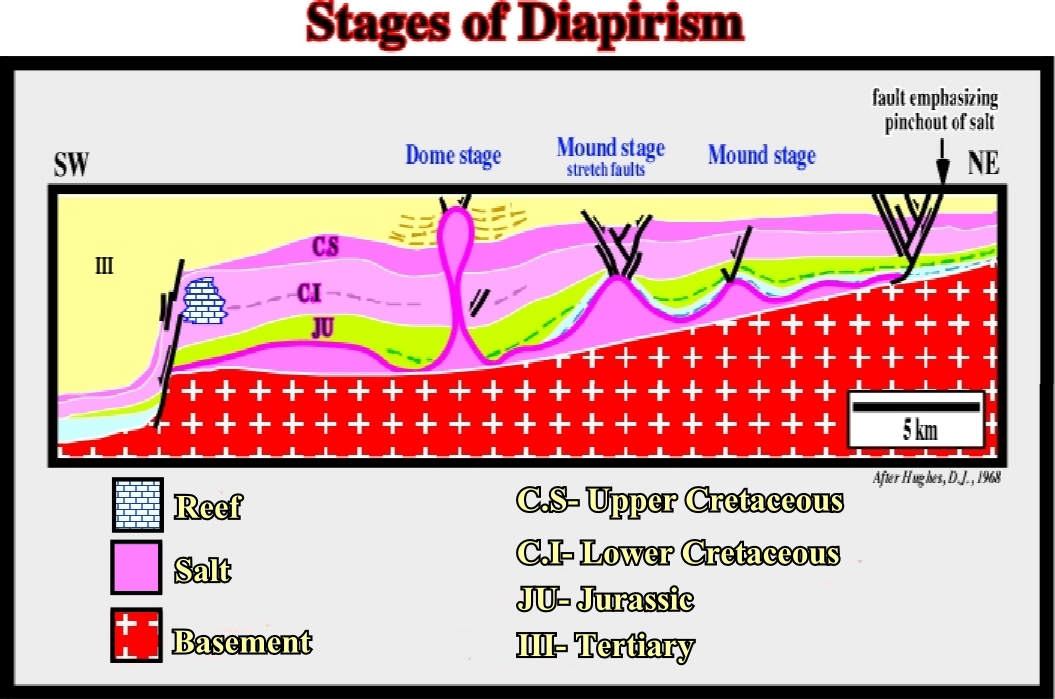
The differentiation of these different stages of a salt dome evolution is quite important. The petroleum systems, and particularly the entrapment-migration petroleum sub-system, are very different from one stage to another (see end of this chapter). The first two stages, the mound and the dome stages, are well illustrated near the margin of the salt basins (GOM, Alabama offshore, Angola offshore, Mediterranean Sea, etc.). The post-dome stage is, mainly, documented by the salt structures found principally in the deep water of the salt basins.
The differential subsidence (compensatory subsidence) induced by salt flowage creates:
a) In the depocenters, around the salt mound, the stratigraphic intervals are thicker.
b) In the uplifted area, where the subsidence is smaller, the stratigraphic intervals are thinner.
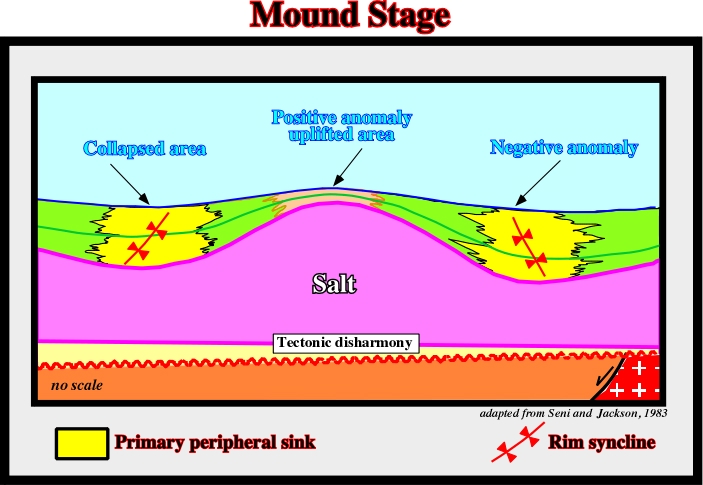
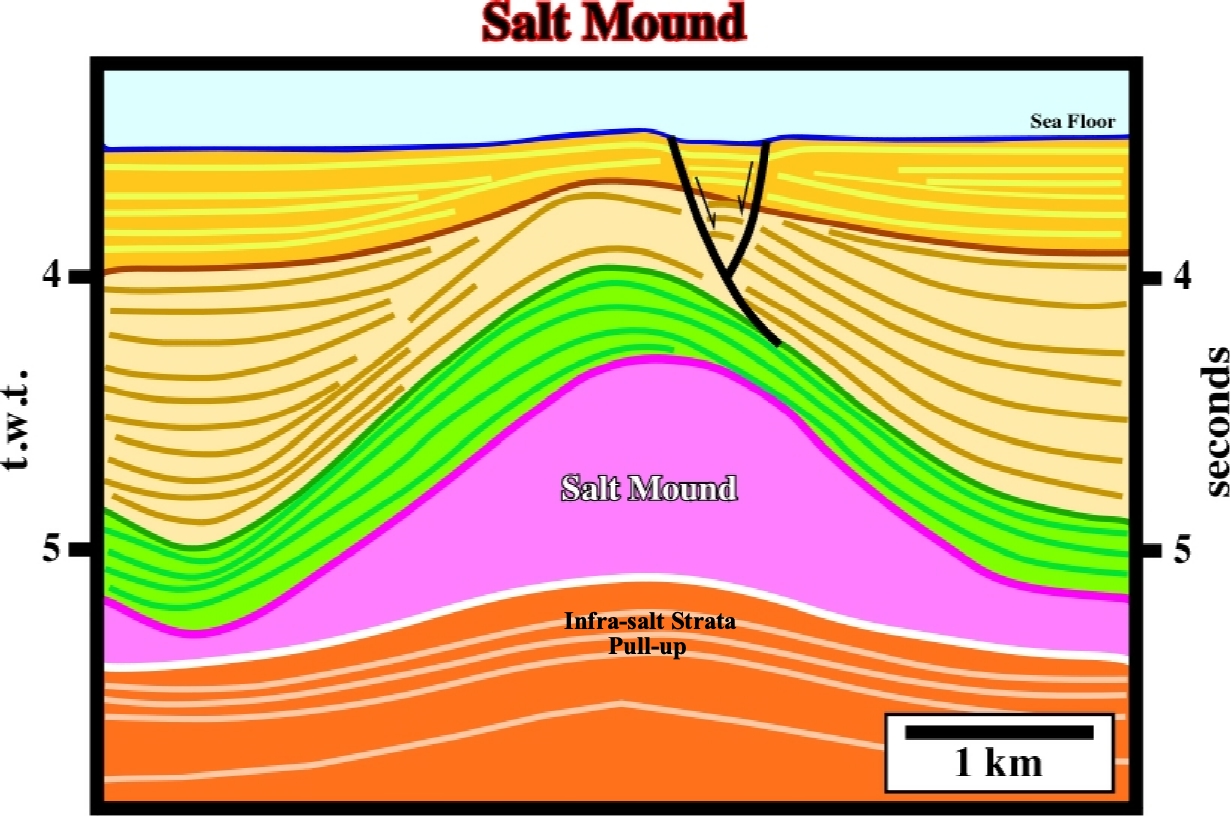
Fig. 140- On this tentative interpretation of a Mediterranean Sea seismic line, the mound stage is well illustrated. It is important to take into account: (i) The tectonic disharmony at the base of the salt ; (ii) The pull-up of the infra-salt strata reflectors induced by lateral changes in interval velocity ; (iii) The pre-kinematic interval of the overburden (green interval) ; (iv) The tectonically enhanced unconformities, which emphasize salt movement pulsations (relative sea level changes) ; (iv) The onset of normal faulting in the uplift area and (v) The salt induced bathymetric anomalies at the sea floor.
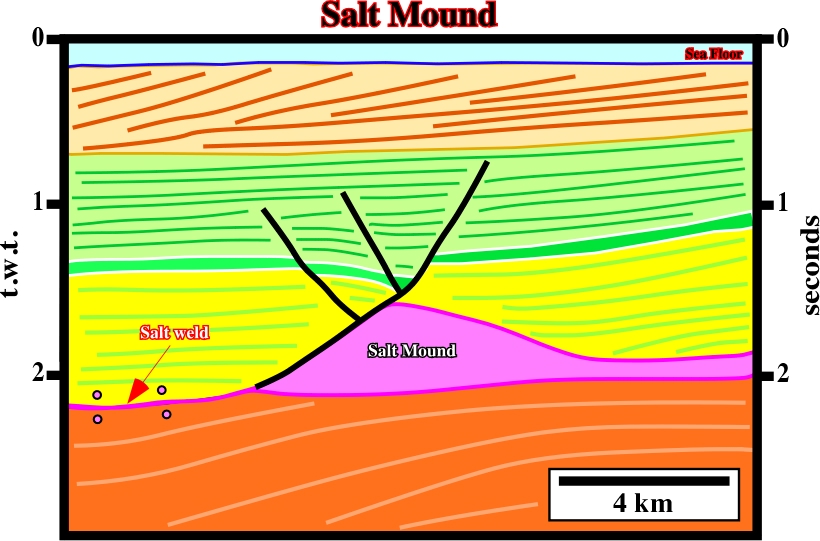
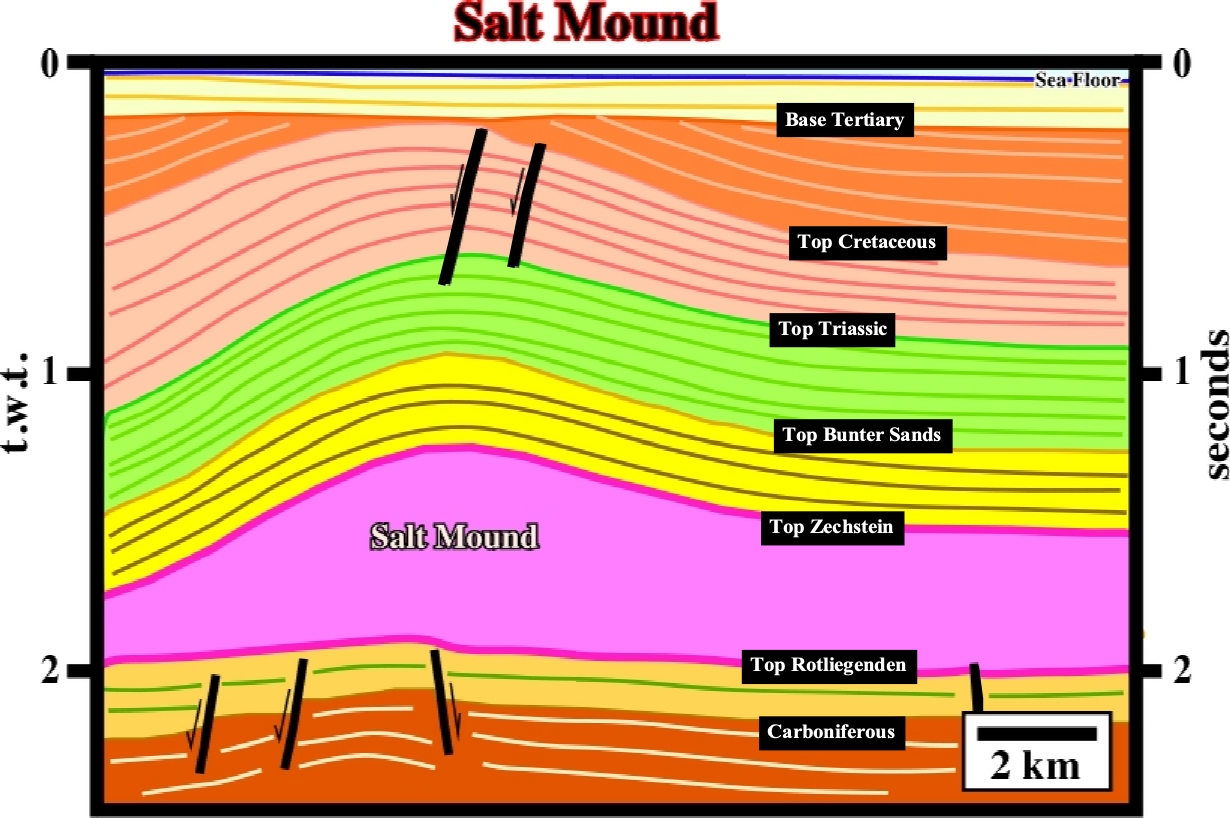
Fig. 142- This tentative interpretation of a North Sea seismic line illustrates a Zechstein mound formed created during the Cretaceous. The Cretaceous sediments show strong thickening on the left end of the line. The yellow and green intervals are pre-kinematic. The bottom of the Zechstein emphasizes a tectonic disharmony (décollement). The cover (salt+ overburden) is decoupled from the sub-salt strata.
The continuation of the salt flowage from the flanks toward the central part of the mound, as the thickness of the overburden increases (depocenters), creates an uplift of the apex of the mound forming a dome structure or diapir. The compensatory subsidence induced by the salt movements creates depocenters in the overburden, in which the central parts are displaced toward the dome. The apex of the dome continues to rise until the salt of the dome will be completely isolated from the mother salt rock. In such a geological situation, the flanks of the mature dome are almost vertical. However, as said previously, due to the geostatic inversion point, such a sub-vertical geometry is mechanically unstable. With time the unstable dome geometry changes to a stable post-dome geometry.
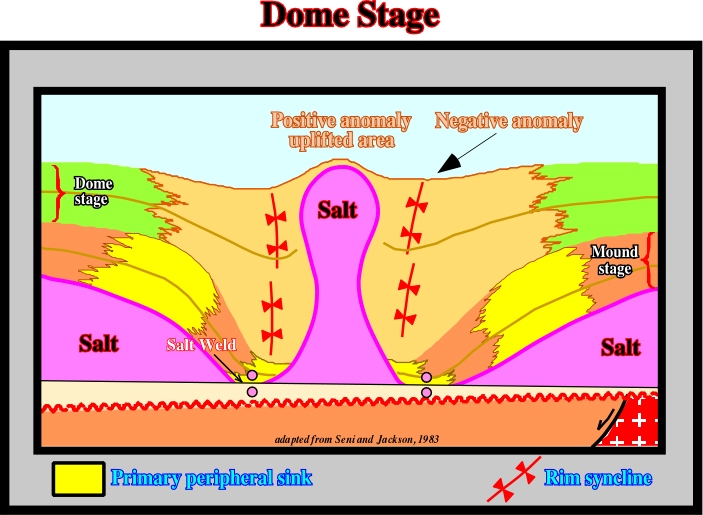
Fig. 143- When a salt structure reaches the dome stage, the structure is, generally, disconnected from the mother salt layer and thick overburden depocenter are developed around the dome. The depocenters developed during the mound stage are, generally, located outward of those associated with the dome stage. In other words, the depocenters migrate toward the flanks of the dome.
The dome stage is often recognized on the salt structures of the North Sea. On the tentative geologicl interpretation interpreted of a seismic line of this area, illustrated in fig. 144, one can see:
a) Three salt dome structures with slightly different ages.
b) The structures (dome stage) do not seem to be disconnected from the salt mother layer.
c) Interdomal turtle-back structures.
d) Pre-kinematic, syn-kinematic and post-kinematic intervals.
e) The normal-faults affecting the infra-salt strata postdate salt deposition (see later).
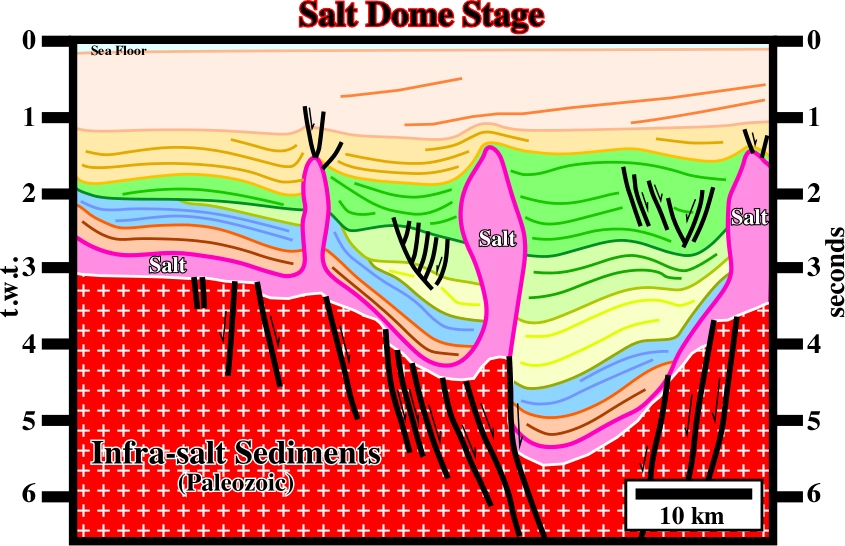
Fig. 144- In the area where this seismic line of this tentative interpretation was shot, understanding the salt tectonics is absolutely necessary. The conventional petroleum system (Carboniferous / Rotlingenden) is associated with the sub-salt strata. The key petroleum parameter is the age of the traps. The age of the infra-salt morphological traps by juxtaposition must pre-date the Zechstein deposition. The age of the normal-faults affecting the infra-salt strata is critical. On this tentative, they seem to pre-date the salt deposition, but, as we will see later, in reality, they post-date the salt deposition.
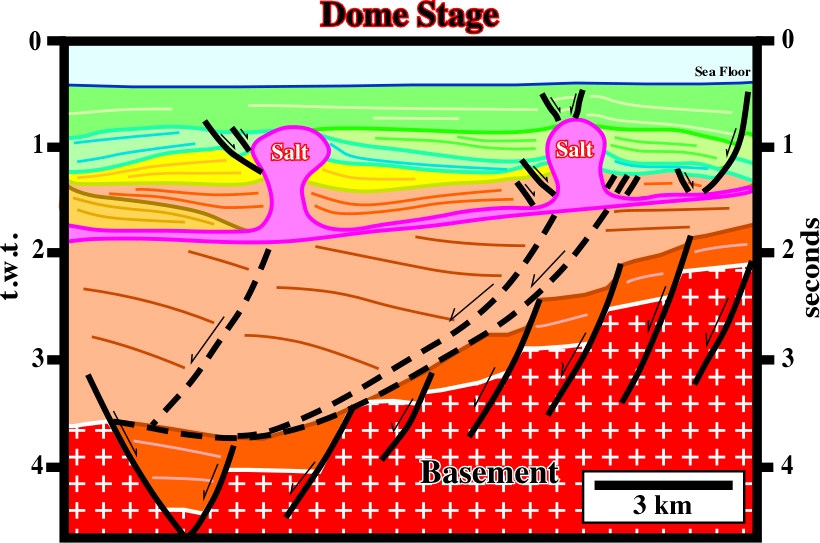
Fig. 145- Salt structures in the dome stage, with the associated overburden depocenters, are quite frequent in offshore Gabon, as illustrated on this tentative interpretation, in which it is interesting to notice the absence, in the overburden, of a pre-kinematic interval. The salt movements started with the deposition of the overburden, or even before. Notice, the lengthening of the Gondwana continental crust during which the rift-type basins were formed and filled, and the thick post-breakup depocenter of infra-salt margin sediments
When a salt dome becomes disconnected from the mother salt layer, it cannot grow anymore. As, the nearly vertical geometry of the flank is an unstable mechanical situation:
- Below the geostatic inversion point, the lateral pressure of overburden against the salt is not balanced by the pressure the salt against the overburden. The salt of the lower part of the dome flows upward.
- Above the inversion point, the salt lateral pressure against the overburden is not compensated by the one induced by the overburden against the salt. The salt flows, laterally, toward the overburden creating overhang structures.
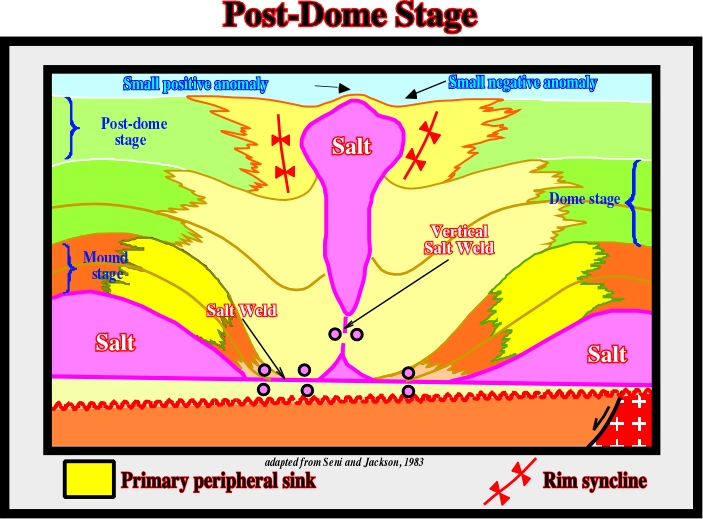
Fig. 146- The displacement of the depocenters toward the dome underlines the direction of increasing of the compensatory subsidence. Generally, in a post-dome stage, there are formation of two horizontal and one vertical salt welds. On the sea floor, a negative bathymetry anomaly surrounds, often, a positive anomaly located just above the top of the salt structure.
- If the difference between the confinement pressures below the inversion point is big enough, the dome can be disconnected from its root creating a drop structure similar to the one illustrated on fig. 146.
- The lateral flow of the salt in the upper part of the dome creates morphological traps by juxtaposition that may be favorable petroleum exploration.
Conventionally, post-dome salt structures were interpreted as large cylindrical domes. However, seismic interpreters, particularly, after the advent of migration processing, soon realized the space problems raised by such interpretations. The idea of using large cylindrical salt domes to store hydrocarbons or radioactive waste was very interesting. Unfortunately, the majority of the wells drilled, to test the salt thickness, after recognizing few ten meters of superficial salt found again sediments (fig. 147 and 148). The wells results, completely, corroborated the conjecture assumed since long-time, by several geoscientists, that seismic images of salt domes with a phallus morphology are just the result of pure naive (inductive) interpretation.
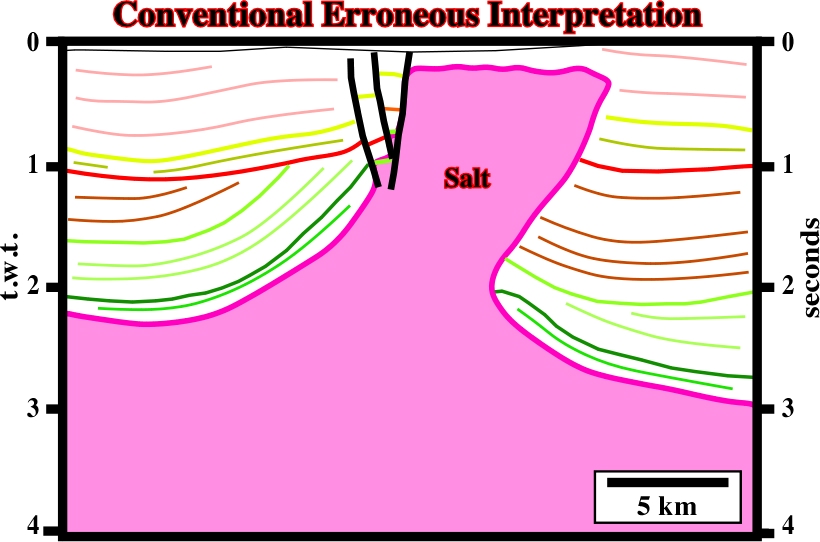
Fig. 147- This tentative interpretation of a seismic line was proposed by a geophysical company to show the possibility of gas storage, in onshore Portugal. The partners of the project asked for a counter-interpretation (fig. 150). The results of the critical and alternative interpretation were so different that they immediately give-up the project.
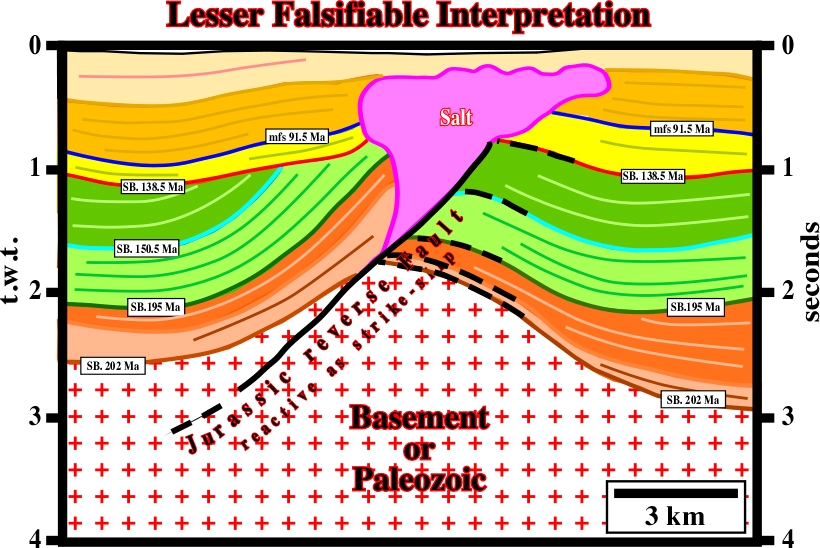
Fig. 148- This alternative tentative interpretation of the previous line was propsosed by C.Cramez and M. Jackson, in 1992. It takes into account the basic principles of seismic reflection, salt tectonics and rheological rock behaviours, i.e., it considers that: (i) a conventional seismic line is a two way time profile, (ii) the density of salt does not change with depth and (iii) the seismic waves travel through salt at constant speed.
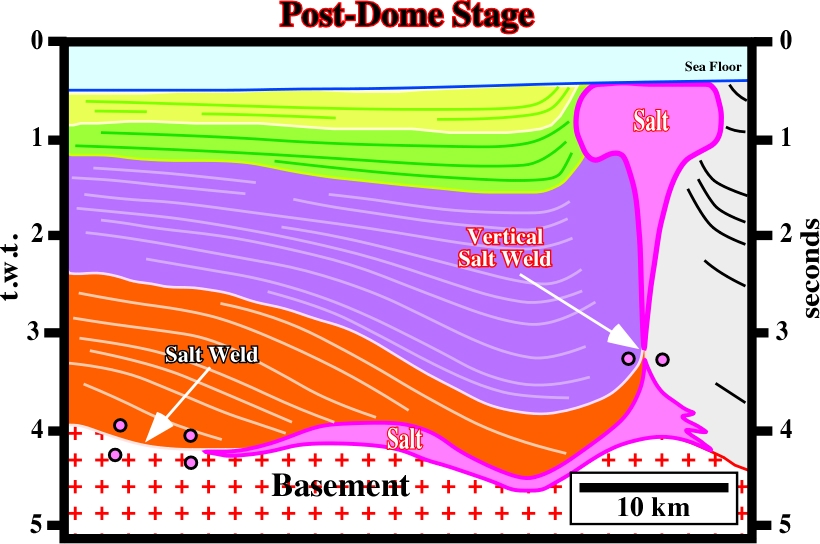
Fig. 149- In Nordkap province , the majority of the Permo-Triassic salt structures show a post-dome geometry, as illustrated on this tentative interpretation of a seismic line of the area. In fact, in conventional seismic lines, salt post-dome structures can only be approached using an hypothetical-deductive interpretation.
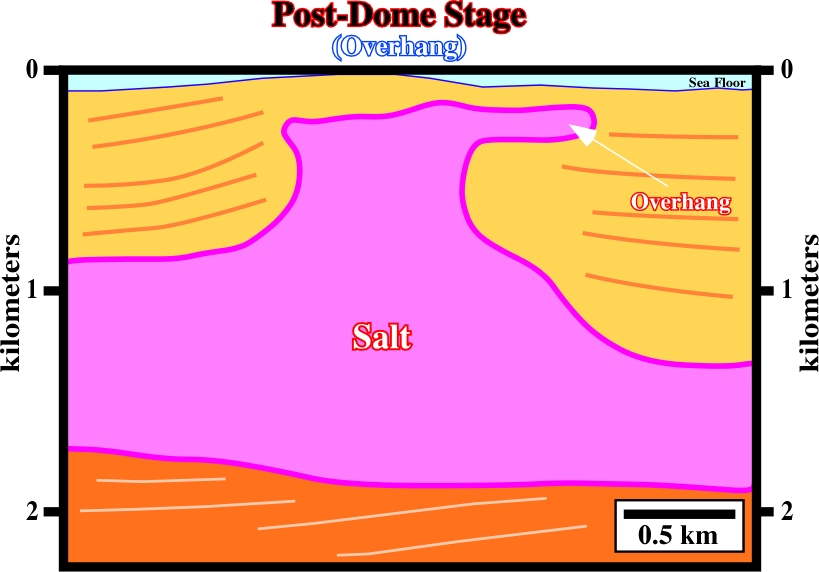
Fig. 150- The overhanging periphery of salt bulbs are characteristics of a post-dome salt stage, as illustrated on this tentative interpretation of an Egypt offshore seismic line. At the sea bottom, the positive topographic anomaly, well developed on this line, emphasizes the upward salt flowage, which contrasts with the lateral movement that creates the overhang (part of the mass of a salt dome that projects out from the top of the dome much like the cap of a mushroom diapir).
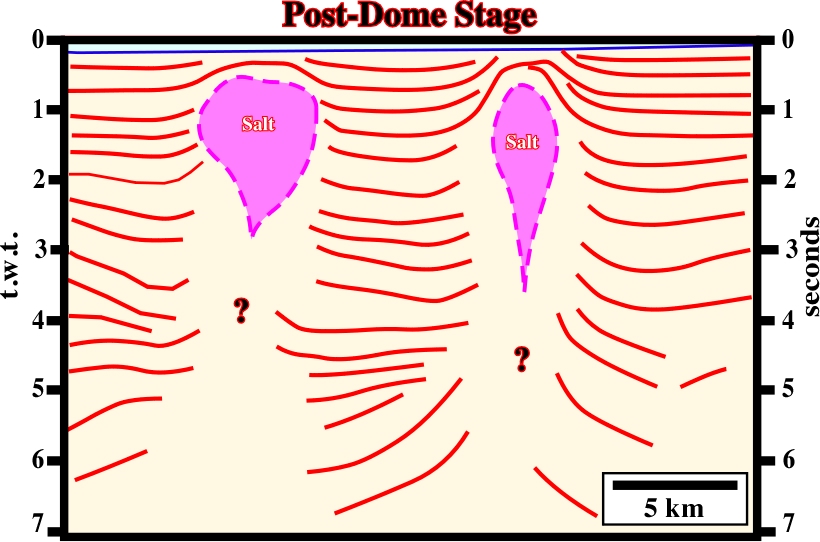
Fig. 151- In the Gulf of Mexico, detached salt stocks, or drop structures, characterize post-dome stages of salt diapirism. They can be associated with autochthonous or allochthonous salt. On this tentative interpretation, it is difficult to identify the salt mother layer., however, two major tectonic disharmonies (décollements) can be recognised at 4.3 and 7.0 seconds.
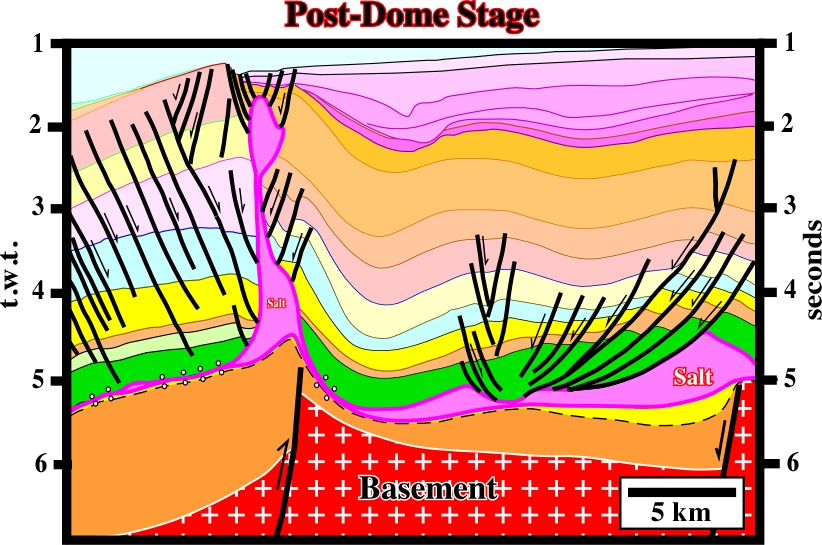
Fig. 152- On this tentative geological interpretation of a seismic line of Angola offshore, at the vertical of a reactivated normal-fault bordering a rift-type basin (?), thereverse movement of the fault seems contribute to the development of post-dome geometry. In other words, a local compressional tectonic regime, and not just the halokinesis, seems to have had a significant role in the development this salt structure,
4.2.1- Sand-Shale Sedimentary Interval
In sand-shale intervals, some possible reservoir and trap distributions are depicted in fig. 153:
-The reservoirs are, generally, located in the areas of maximum subsidence, where accommodation, or available space for sedimentation is higher.
- The traps are mainly non-structural. They are stratigraphic or morphological.
- Structural traps (four way dips) are possible, when the apexes of the turtle-back structures, particularly, those of the mound and dome stages, are not faulted, what is quite difficult, since the sediments of the overburden are lengthened and there is only one way of elongated sedimentary interval, i.e., by normal faulting. However, such a tectonic situation is rare. Turtle-backs are extensional and not compressional structures. Normal faulting lengthens the highest areas of a turtle-back structure. Therefore the traps are morphological by juxtaposition (a fault-trap is a misnomer, a fault trap does not exist, a fault never traps, what can trap is a sealing rock in the other side of the fault when juxtaposed to a reservoir rock).
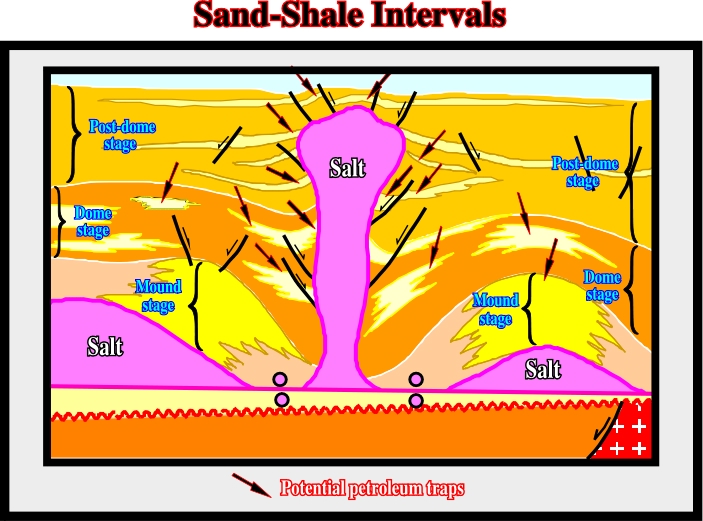
Fig. 153- This sketch illustrates the three diapiric stages of an upward salt flowage and the location of the more likely reservoir-entrapment petroleum subsystem, in a sand-shale geological setting.
4.2.2- Carbonate Sedimentary Interval
In carbonate intervals, the more likely locations of the potential reservoirs and traps are quite different than those in a sand-shale interval, as illustrated in fig. 154:
- The potential carbonate reservoirs are, mainly, high-energy deposits, where carbonate production is greater.
- The more likely traps are non-structural:
a) Stratigraphic and morphological by juxtaposition traps are by far the more frequent. The trap classification used in these notes and, particularly, the term « morphological traps by juxtaposition » indicate, clearly, that the mapping of the sealing rock, which defines the closed area, is as important as the mapping of the reservoir. Without the map of the sealing rock, it is impossible to define a morphological trap, particularly, when the morphology is related to a fault escarpment. are by far the more frequent.
b) Due to salt withdrawal, some of the stratigraphic traps are located on the flanks of structural lows (tectonic inversion). In the Angola conventional offshore, several well-known oil fields are associated with this kind of tectonic inversion.
c) Structural traps, that is to say, traps with four way dip closure, when present (between two normal faults), are generally too small to accumulate economic amounts of hydrocarbons. The reservoirs when present are quite restricted and their petrophysical characteristics are mediocre.
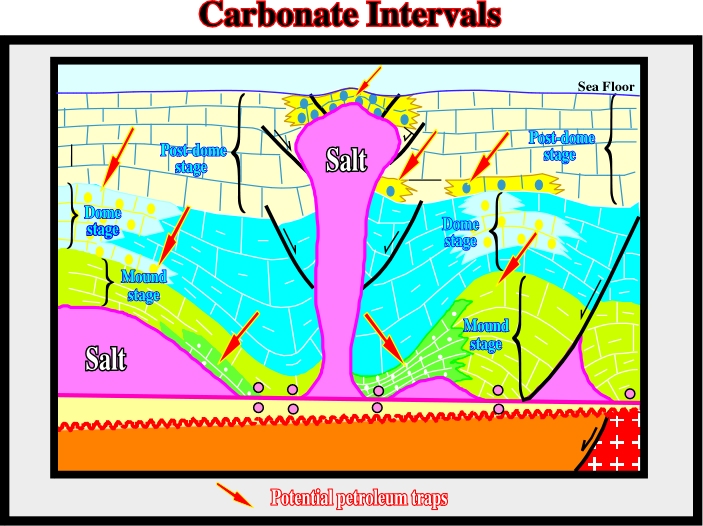
Fig. 154- When a carbonate interval is coeval with salt flowage, the more likely location of the potential reservoirs and traps depends on the water depth created by the compensatory subsidence. Shallow water depths induce high-energy depositional environments, in which reservoirs are likely. TPhe potential reservoirs are, generally, associated with thinner stratigraphic intervals deposited in shallow water depth
In 1984 Total’s geologists proposed these kind of tectonic inversion induced by salt withdrawal to explain the structures and the reservoir facies distribution of the Pinda formation, in block 2 of Angola offshore (fig. 155). This model (raft tectonics) was proposed as an alternative to the “shoal model”, which had been systematically refuted by the exploratory wells. In salt withdrawal model, the carbonate reservoirs are mainly controlled by halokinesis. Carbonate reservoir facies are deposited over the Loeme salt structural highs. However, following salt withdrawals and lateral salt flowage, structural inversions take place and the initial structural high areas become structural lows (e.g. Lombo East#1, Tubarão#1, Sulele #1, etc.).
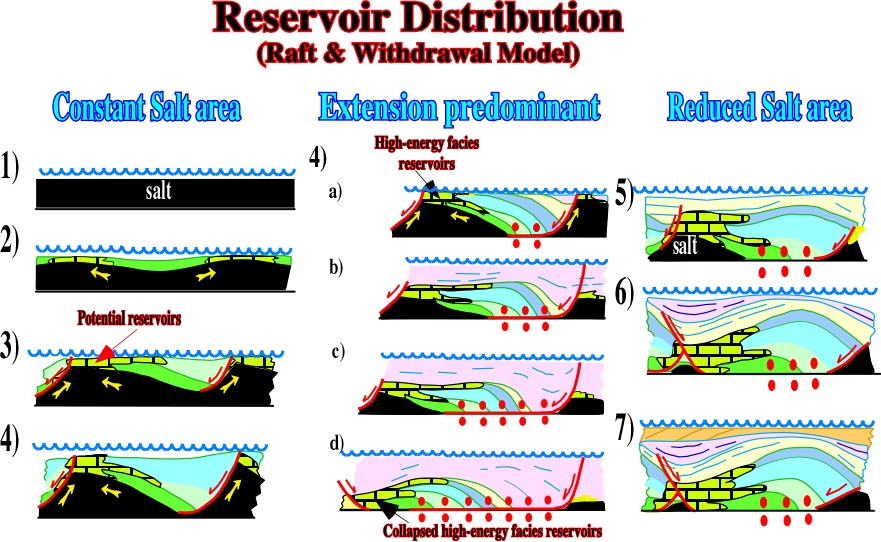
Fig. 155- Total (today TotalEnergies) proposed raft-tectonics with salt withdrawal to explain structures and reservoirs facies distribution of the Pinda formation in block 2 of Angola offshore. Roughly, in the raft tectonic model, the carbonate sedimentation is, mainly, controlled by the halokinesis thereby the reservoir facies are deposited over Loeme salt structural highs. However, due to salt withdrawals and lateral salt flowage, structural inversions are created and the initial structural high areas become structural lows. This salt tectonic model was corroborated, mainly, by the discoveries of Lombo East, Tubarão, Sulele, etc.. Nevertheless, this model can not explain all Pinda structures and reservoir distribution. It seems that it was, partially, refuted by new geological and geophysical observed data
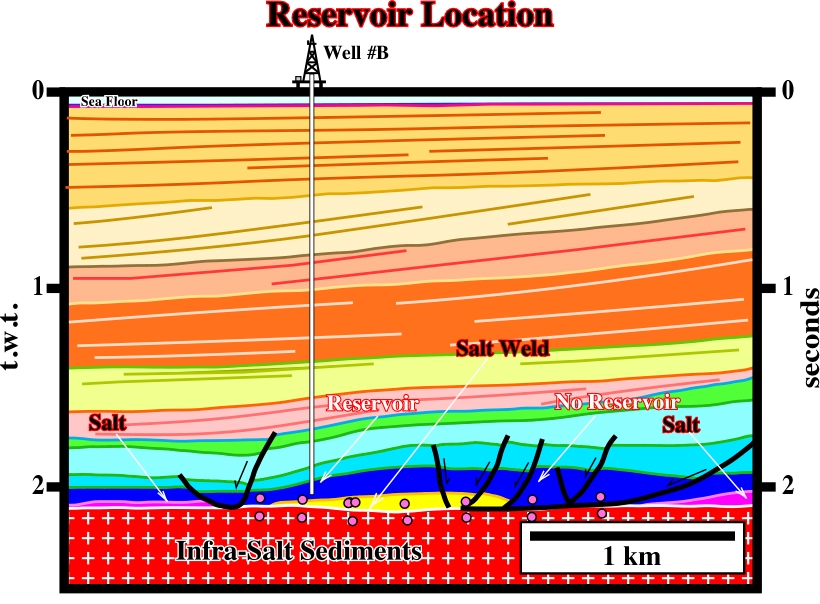
Fig. 156- This tentative interpretation of a seismic line from Angola conventional offshore, illustrates that the reservoir location, in Sulele West, follows the raft and withdrawal model depicted in fig. 155. The Middle Pinda interval (dark blue interval), progressively, thins westward. Such thinning correlates with an increasing of the reservoir qualities of the high-energy carbonates. Eastward, where all Pinda intervals become thicker there are no reservoirs. So, obviously, the trapping mechanism is mainly stratigraphic.
Fig. 157- This interpretation of a seismic line across Benza Quitel #1, drilled Angola onshore (Kwanza geographic basin), illustrates the case of a sand-shale interval deposited during salt flowage. The sandstone reservoirs are, progressively thicker, in the hanging-wall of the faults with a left vergence, where the compensatory subsidence was higher. Again, the trapping mechanism is mainly stratigraphic. The sandstone reservoirs pinch-out up-dip.
to continue press
next